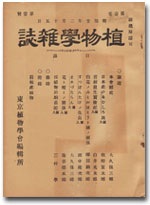All issues

Volume 76, Issue 902
Displaying 1-6 of 6 articles from this issue
- |<
- <
- 1
- >
- >|
-
Shizuo HATTORI, Mitsuhiko SATO1963 Volume 76 Issue 902 Pages 273-278
Published: 1963
Released on J-STAGE: December 05, 2006
JOURNAL FREE ACCESS1) The dahlia tuber possesses a series of non-reducing oligosaccharides, which are composed of one glucose unit and certain numbers of fructose unit and have a sucrosyl part somewhere in the molecule, and they seem to be identical with the oligosaccharides which have already been found in Jerusalem artichoke tuber.
2) The position of glucosyl residue, which has not been definitely elucidated in the artichoke oligosaccharides, was determined in the present study to situate at the end of each sugar. The oligosaccharides in dahlia tuber, and possibly those in artichoke tuber, may be, therefore, sucrose, fructosyl sucrose (kestose), difructosyl-sucrose and so on.View full abstractDownload PDF (601K) -
Mitsuhiko SATO, Atsushi KOMAMINE, Masami SHIMOKORIYAMA1963 Volume 76 Issue 902 Pages 279-285
Published: 1963
Released on J-STAGE: December 05, 2006
JOURNAL FREE ACCESSIn this report, the outgrowth whose characteristics have already been described is examined for its IAA metabolism with special reference to its IAA destructive activity.
1) The outgrowth formation from the cut surface of the epicotyl was remarkably accelerated by the application of IAA. This was observed not only in the lower parts of epicotyl, but also in the growing area which did not develop any outgrowth when subjected only to cutting. It is suggested that a relatively large amount of IAA may accumulate in the cut region and take a part in the formation of the outgrowth.
2) The outgrowth was found to possess a considerably high amount of IAA as compared with non-outgrowth epicotyl.
3) The maintenance by the outgrowth of such a high level of IAA may be, in part, attributed to the decreased rate of its in vivo IAA destruction. The authors express their thanks to Dr. Hiroh Shibaoka, Botanical Garden of University of Tokyo, for his kind help in IAA analysis.View full abstractDownload PDF (1163K) -
Tuguo TATEOKA1963 Volume 76 Issue 902 Pages 286-291
Published: 1963
Released on J-STAGE: December 05, 2006
JOURNAL FREE ACCESSLeaf-structure of Arthropogon, Achlaena and Reynaudia was examined. All species showed panicoid features in histological and anatomical characters, but three different types were recognized. Type 3 is characterized by the distinctive, circular cells which are scattered in the mesophyll and are similar in appearances to the outer sheath-cells. In Type 2, a few small vascular bundles appear below bulliform cells between the veins. Type 1 has no distinctive cell nor such small vascular bundle as found in Type 2. To Type 1 only Reynaudia filiformis belongs. Arthropogon villosus and A. xerachne have the Type 2 leaf-anatomy, and Arthropogon scaber is closer to Achlaena piptostachya in leaf-structure and morphological characters than to the other two species of Arthropogon. Achlaena can hardly be maintained as an independent genus, so it has been reduced to a synonym of Arthropogon. Morphological and leaf-anatomical properties of Arthropogon suggest that this genus may represent an intermediate taxon between Arundinelleae and Paniceae.View full abstractDownload PDF (859K) -
Kazuyoshi HIROMOTO1963 Volume 76 Issue 902 Pages 292-298
Published: 1963
Released on J-STAGE: December 05, 2006
JOURNAL FREE ACCESS1. In natural mycorrhiza, as well as in synthetic one, of Pinus densiflora with Armillaria matsutake the hyphae enter into the outer brown-colored cortical cells, but they cannot be found in the inner well-swollen, vivid, colorless cells; they cannot be seen also in well-swollen cylindrical colorless epidermal cells.
2. The investigation to obtain mycorrhiza was tried successfully by cultivating both the gills taken from the fruit body of Armillaria matsutake and the seedlings of Pinus densiflora on fructose-galactose agar culture medium.
3. Judging from the results of pure culture (slow growth of the mycelia) and of the investigation to obtain mycorrhiza, the mycorrhizal establishment of Armillaria matsutake with Pinus densiflora in the forest seems to be very rare.View full abstractDownload PDF (1865K) -
Masao KUMAZAWA1963 Volume 76 Issue 902 Pages 299-308
Published: 1963
Released on J-STAGE: December 05, 2006
JOURNAL FREE ACCESSThe frequency variations in the primary and secondary branches with cathodic prophylls were studied (Figs. 1-3). The secondary branches on the well-developed primary branches are alike to the branches themselves in the frequency distribution of cathodic prophylls, some ones at the basal part of their mother axis being excepted. However, the secondary branches on the short primary branches provided with a small number of nodes and those on the well-developed primary branches show the frequency distributions of cathodic prophylls different from each other (Fig. 5). As for this fact, it is interpreted that the prophyll position on the secondary branch axes, produced at the uppermost several nodes of a primary branch may be determined by some terminal effects of the primary branch axis.
The lateral branch whose third leaf is adaxial in position is found most frequently at the lower several nodes of the main axis (Table 4), as in the case of Xanthium2). Phyllotaxis in the proximal portion of the primary branch (Fig. 6) is similar to that of Xanthium2) in the fundamental pattern.
Plastochrone changes during plant development were studied in relation to the frequency variation of cathodic prophylls (Tables 2-3). The L-plastochrone and P-plastochrone are successively reduced, being attended with plant development. Each LP-plastochrone is elongated successively until a certain stage of development and then it becomes gradually reduced (Figs. 3-4). In response to the LP-plastochrone reduction, the frequency of cathodic prophylls falls also gradually.View full abstractDownload PDF (1135K) -
Masahiro SUGIURA1963 Volume 76 Issue 902 Pages 309-310
Published: 1963
Released on J-STAGE: December 05, 2006
JOURNAL FREE ACCESSDownload PDF (246K)
- |<
- <
- 1
- >
- >|